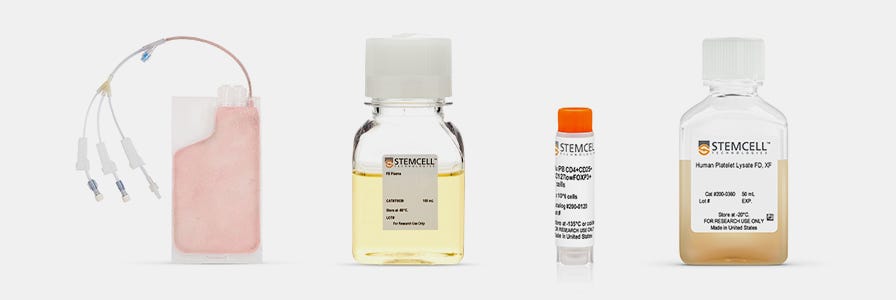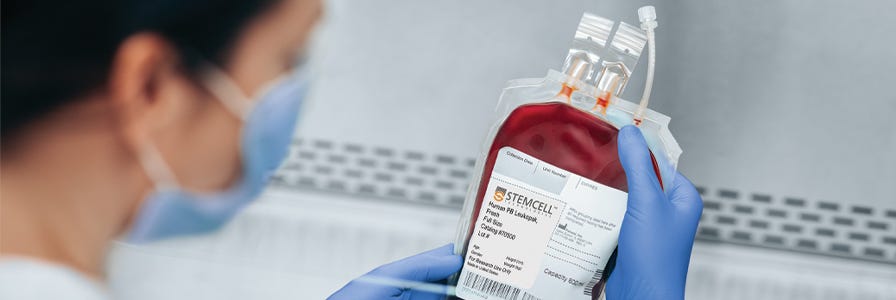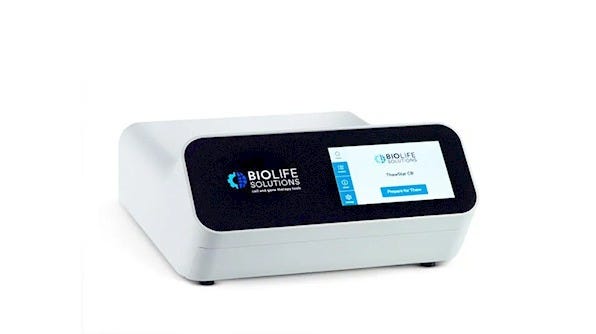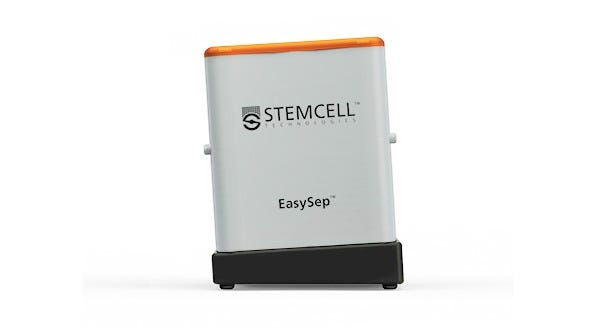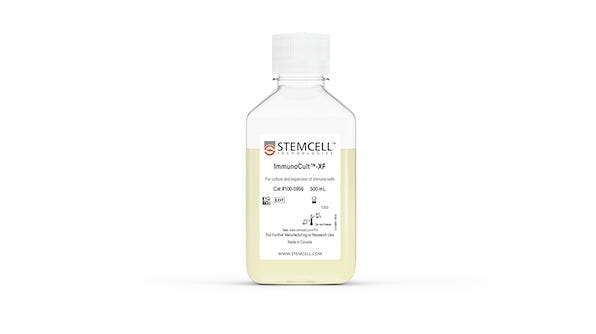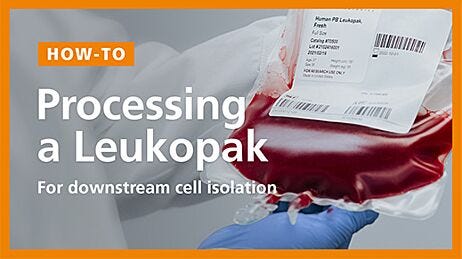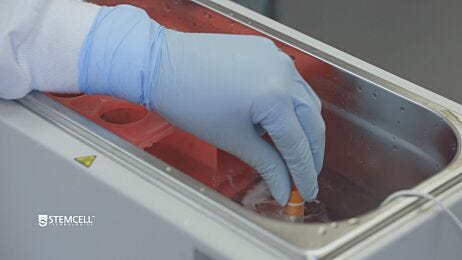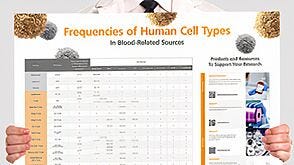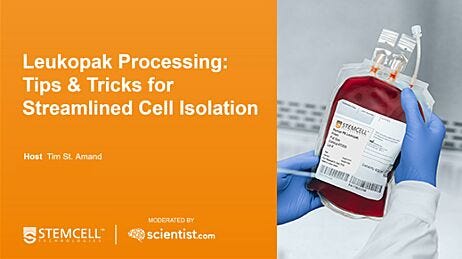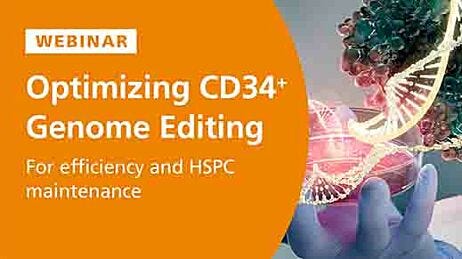Peripheral Blood Leukopaks
To Streamline Your Large-Scale Studies
What Is a Leukopak?
Leukopaks are enriched leukapheresis* products containing a variety of immune cells, including T cells, B cells, natural killer (NK) cells, monocytes, etc. Compared to whole blood and buffy coat, a full-size leukopak contains much higher concentrations of leukocytes per volume—typically greater than 9 billion cells in an average volume of < 200 mL. This makes leukopaks an ideal source of human primary cells when large numbers of cells are required from a single donor, especially for researchers working on adoptive cell therapy, T cell receptor (TCR) sequencing, and immunotherapy development.
By allowing for scalability, consistency in cell composition, and reproducibility of experiments, leukopaks are an integral tool for researchers working on immune studies and cell therapy. Compared to other cell sources, such as whole blood and PBMCs, leukopaks also offer higher yields of multiple immune cell types, standardization of your assays, and flexibility in experiments due to long-term storage capabilities.
For a reference on the typical frequencies of each cell type in different cell sources, including leukopaks, whole blood, and peripheral blood mononuclear cells (PBMCs), get your free copy of the Frequencies of Human Cell Types in Blood-Related Sources wallchart.
How Are Leukopaks Collected?
Leukapheresis
Leukapheresis is a specific type of apheresis in which leukocytes are extracted from a blood donor while returning other blood components to the donor in one process. In the case of leukopak production, the following steps are undertaken as part of the leukapheresis process:
- Whole blood is collected from the donor through an intravenous tube in one arm.
- The collected blood is passed through an apheresis machine that separates the white blood cells from the blood.
- The remaining blood components are returned through an intravenous tube in the other arm of the donor.
- The white blood cells are collected in sterile bags for storage and later shipment.

Figure 1. Leukapheresis Process
A typical leukapheresis process showing the extraction of leukocytes from a blood donor and the returning of other blood components to the donor in one process.
Why Choose Peripheral Blood Leukopaks from STEMCELL Technologies?
STEMCELL offers a comprehensive collection of ethically sourced, cryopreserved or fresh peripheral blood (PB) leukopaks or leukapheresis products* to support your research needs. Ensure continuity in your research and start experiments according to your schedule with a reliable supply of high-quality, single-donor sourced primary cells that are ready to use upon receipt. Leukopaks are shipped with a lot-specific Certificate of Analysis (CoA) indicating the guaranteed viability and purity of your product.
Why Use Human Peripheral Blood Leukopaks from STEMCELL?
- Choose cells that are more physiologically representative of cells in vivo
- Access donor samples collected using regulatory authority-approved consent forms and protocols
- Start your experiments on your schedule without being restricted by the availability of tissue
- Obtain large numbers of single-donor leukocytes,including PBMCs, T cells, and more
- Reduce time spent collecting and culturing primary cells
Learn more about how we can work closely with you as your primary cells supplier.
What Types of Leukopaks Are Available from STEMCELL?
Normal (Non-Mobilized) Leukopaks
STEMCELL provides both fresh and frozen normal leukopaks, available in full, half, quarter, and tenth sizes, which are collected in transfer bags using stringent and consistent protocols. Each full-sized leukopak is produced from ~2 - 3x blood volumes using the Spectra Optia® Apheresis System, with acid-citrate-dextrose solution A (ACDA) as the anticoagulant.
Fresh Leukopaks
Fresh leukopaks are typically used to study the functions of white blood cells within a short period of time after collection. This is because fresh leukopaks contain viable and functional white blood cells that can be used immediately after collection without any loss of viability or functionality. STEMCELL’s recent stability study suggests that fresh leukopaks can be stored at 2 - 8°C for up to 5 days post-apheresis. Fresh leukopaks are available in full (10 billion cells), half (5 billion cells), quarter (2.5 billion cells), and tenth (1 billion cells) sizes for your research. STEMCELL also offers fresh leukopaks from donors diagnosed with a type of solid tumor cancer, hematological cancer, autoimmune or inflammatory diseases in different sizes.

Figure 2. Recovery of Viable Cells Is Higher When Leukopaks Are Stored at Fridge Temperature Compared to Room Temperature
Stability of fresh leukopaks (LP) was evaluated after storage for up to 5 days after collection, at a refrigerated temperature (FT; 2 - 8°C) or at room temperature (RT; 15 - 25°C). Full leukopaks were collected from three unique donors, then divided into ten equally sized fractions and stored at FT or RT (n = 5 for each temperature, per donor). Over the following 5 days, one 1/10th leukopak fraction was processed from each condition, daily, to identify changes in cellular composition and functionality that may have occurred during storage. (A) Viable cell yield and (B) percentage cell viability were determined daily after performing red blood cell (RBC) lysis of leukopak fractions. By Day 5 after collection, leukopak fractions stored at RT showed a 68% loss of viable cells and an accompanying 54% decrease in cell viability. Conversely, those stored at FT showed a much less pronounced decrease (19%) of viable cells and just a 5% decrease in viability over the 5 days. All data points represent the average ± standard deviation values from leukopak fractions of 3 unique donors.
To learn more about the stability of fresh leukopaks, see Stability Study Data.
Frozen or Cryopreserved Leukopaks
Frozen leukopaks, as the name suggests, are leukopaks that are cryopreserved and stored at a subzero temperature (normally ≤ -135°C) to preserve the biological sample for long-term storage. At STEMCELL, frozen leukopaks are processed shortly after collection, following stringent protocols, and cryopreserved in CryoStor® CS10—preserving quality and ensuring optimal cell viability and purity post-thaw. The Certificate of Analysis (CoA) for frozen leukopaks now includes flow cytometry plots showing the percentage of monocytes (CD14+), B cells (CD19+), T cells (CD3+, CD4+, CD8+), and NK cells (CD56+CD3-).
Our PB Leukopak Products Portfolio*
Explore our range of ethically sourced human PB non-mobilized leukopak products to streamline your research:
Fresh Leukopaks
Get large numbers of fresh single-donor PBMCs in a selection of leukopak sizes.
Frozen Leukopaks
Obtain large numbers of cryopreserved single-donor PBMCs and begin experiments when you are ready.
What Type of Normal Leukopak Is Best for Your Research?
The choice of whether to use fresh or frozen normal leukopaks depends on the specific needs of your experiment, such as cell type and functionality, logistics, availability, and timing flexibility. Thus, choosing a supplier that ensures a reliable supply of cells, with maintained quality and viability throughout the collection and shipping process, is imperative to the success of your large-scale studies. Table 1 compares some of the features of normal fresh or frozen leukopaks based on different factors that can impact your application and research goals.
Table 1. Factors to Consider When Choosing the Right Leukopak Product for Your Research
| Factor | Fresh Leukopaks | Frozen Leukopaks |
|---|---|---|
| Cell Type and Functionality | Optimal for experiments requiring high cell functionality or sensitive cell types such as NK cells and dendritic cells Isolated cells have higher viability as no cryopreservation step is involved. |
Cryopreservation ensures long-term stability of cells with ≥ 90% viability. Cells cryopreserved on the same day as collection typically outperform cells cryopreserved after overnight shipment. |
| Logistics and Availability | Inherent risk of shipping delays can impact the quality of cells. Fresh leukopaks are less readily available. |
Eliminate the inherent risk of shipping delays, with no decrease in cell quality. Frozen leukopaks are more readily available and can be used for multiple experiments. |
| Downstream Application | Ideal for time-sensitive assays and assays requiring optimal cell functionality. Fresh leukopaks can be processed and cryopreserved upon receipt. |
Suitable for assays requiring a large number of cells or experiments conducted over extended periods of time. It is not recommended to re-cryopreserve as a second freeze-thaw will result in increased cell death. |
What Are the Frequencies of Different Cell Types in a Leukopak?
Leukopaks contain higher concentrations of mononuclear cells, B cells, T cells, stem/progenitor cells, and other cell types compared to whole blood or buffy coat products. Figure 3 shows the mean percentage of cell subpopulations in a frozen leukopak. The total volume and concentration of the supplied cells vary depending upon the donor. STEMCELL provides the exact frequency of different cell types in the leukopak you receive as a flow plot on the Certificate of Analysis (CoA) for all frozen leukopaks. The flow cytometry plots include the percentage of monocytes (CD14+), B cells (CD19+), T cells (CD3+, CD4+, CD8+), and NK cells (CD56+CD3-). For fresh leukopaks, the additional flow cytometry analysis is available for an additional fee when requested. For fresh mobilized leukopaks, the flow cytometry panel also includes the frequencies of CD34+ cells and flow plots are provided on the CoA for all mobilized leukopaks.

Figure 3. Mean Percentages of Cell Subpopulations in a Frozen Leukopak
Representative chart showing the average frequencies of major immune subsets in leukopak products, as measured by flow cytometry before cryopreservation. Values shown are mean percentages of total viable leukocytes present in a frozen leukopak (n ≥ 30). Actual percentages will vary from donor to donor. The exact frequency of these cell types in the leukopak you receive will be provided as a flow plot on the Certificate of Analysis for all frozen leukopaks and is available as an additional fee for fresh leukopaks.
Request an Offer for Human Primary Cells
Fill out this form to request information about introductory offers to try STEMCELL’s human primary cell products.
Frequently Asked Questions on Primary Cells
Find answers to frequently asked questions on our leukopaks and other primary cell products.
*Certain products are only available in select territories. Please contact your sales representative or the Product & Scientific Support team at techsupport@stemcell.com for further information.
Get the Custom Cell Products and Assay Services You Need
STEMCELL is committed to helping you find the right human primary cells as well as providing expert assay services customized to fit your research specifications and needs.
Primary Cell-Based Assay Services
Partner with our in-house Contract Assay Services (CAS) team to design and complete your drug discovery and development studies. Get the data you require by choosing from our portfolio of standardized assays or discuss your customized needs with our scientific experts.
Custom Products
Get custom primary cell products, including unique peripheral blood isolations, collections using alternative anticoagulants, and donor-matched collections; products subjected to additional testing; and more.
Contact our primary cells team or your sales representative to discuss your specific regulatory or custom product requirements.
Large Scale Workflow Solutions
Explore some of our cell processing technologies and resources to support the standardization of your large-scale cell culture workflows.
ThawSTAR® Automated Thawing Systems
Increase confidence in your cell thawing workflow and ensure sample sterility and consistent thawing performance by using the ThawSTAR® CFT2 and ThawSTAR® CB Automated Thawing Systems. With a standardized thawing process that replaces manual, water bath-based thawing, ThawSTAR® systems eliminate the risk of contamination and deliver controlled thawing profiles.
Easy 250 EasySep™ Magnet
Scale up your manual cell isolations from large-volume samples such as leukopaks and whole blood. Rather than splitting your cell suspension and performing multiple rounds of isolations, with the Easy 250 EasySep™ magnet, you can process up to 225 mL and 1.25 x 1010 cells at once in as little as 20 minutes. STEMCELL also offers large-scale format EasySep™ cell isolation kits for rapidly processing samples of up to 1 x 1010 cells for downstream applications.
Looking for tips and tools for isolating cells from large-volume samples? Learn more by visiting our Efficient Large-Scale Cell Isolation page.
ImmunoCult™-XF
Confidently expand T cells for use in clinical applications without the need for serum or serum derivatives with ImmunoCult™-XF. This xeno-free, ready-to-use medium is manufactured under relevant cGMPs and remains free of added cytokines, ensuring the flexibility of your workflow.
Protocols and Resources for Your Cell-Based Assays
Discover protocols and technical resources to help you work with human primary cells in your research.






